If you grew up a petrolhead and a Ferrari aficionado in the nineties, there’s a tremendous possibility you secretly lusted over the Ferrari F50 during those glorious times.
Despite being too embarrassed perhaps to hang its poster on your bedroom wall, I’m sure if given the opportunity, you too would have driven it recklessly in Need for Speed II. Regardless of what everyone said back in the days, this supercar must have influenced your formative automotive years and the F50 feasibly still retains a special place in your heart.
And why shouldn’t it, really? It was one of the most daring roadgoing Ferraris ever created, with Formula 1 DNA all over it, and as such, it was an honest tribute to the late Enzo Ferrari and fifty years of legacy he created.
On the other hand, the grown-up automotive world disputed the F50’s odd design, deeming it underwhelming compared to the F40’s captivating looks and iconic aura. While that is true to a certain degree, the vehicle was still a spectacular driver’s car in a controversial package.
From today’s perspective, Ferrari F50 is one of the all-time greatest cars, not just for Ferrari, but for the entire automotive world. Still, it faced a rather rocky origin and late recognition. To fully appreciate it and find its exact place in the automotive pantheon, let’s dig deeper into all its rights and wrongs.

Background
The history of a modern Ferrari halo car can be directly traced to the 288 GTO. A powerful 1980s take on the Gran Turismo Omologato values; this mid-engined V8-powered twin-turbocharged icon disrupted the V12-in-the-front mantra of the 250 GTO.

The GTO nameplate wasn’t resurrected without a good reason because the 288 GTO was built specifically to be homologated for Group B racing. While it did see merely a fraction of glory compared to the 250 GTO, this supercar gave birth to a new breed of Maranello’s prized horses.
It was the first in a line of uncompromising mid-engined supercars, a recipe Ferrari continued pushing, creating the distilled 288 GTO Evoluzione – the perfect testbed for the next legendary car, the one marking Ferrari’s 40th anniversary.
The F40 was another masterpiece executed by Nicola Materazzi and the last Ferrari supercar developed with Enzo Ferrari’s personal involvement. After ‘The Old Man’ passed in 1988, Ferrari entered difficult times but recovered thanks to Luca Cordero di Montezemolo who took over in 1991.

Due to being shaken by Enzo’s passing and in part because of enormous interest, Ferrari manufactured the F40 beyond its original run of 400 examples. The production continued until 1992, with sales tripling and 1,315 cars assembled. The end of F40’s production coincided with the Japanese real estate bubble, which soon caused a worldwide economic recession, effectively closing one era in Maranello.
Development
Before the early 1990s recession, the automotive world was in quite a complex situation, at least when it came to the booming supercar market. In a short period, numerous new challengers came at Ferrari’s feet. Still, on the other hand, these very same companies were swept away by disappointing sales, a painful consequence of the bubble that created them eventually bursting.

As a result of this wild era, the upcoming ultimate Ferrari had to prove itself against the new generation of supercars such as McLaren F1, Jaguar XJ220, or the Bugatti EB110. Other blisteringly fast oddballs competing for attention were the likes of the Cizeta-Moroder V16-T, Dauer 962C, and Schuppan 962CR, both derivatives of the dominating Porsche 962 endurance race car.
Finally, the F40’s successor was faced with a daunting opponent, the McLaren F1. Gordon Murray’s three-seater maverick already upstaged every supercar it was pitted against, F40 included, and as a true engineering marvel, it was already deemed the ultimate supercar of its generation.
Still, neither of these companies, both big or small, were in as favorable financial situations as Ferrari was. Limiting the production to just 349 cars was not a matter of necessity but a power move of a company that knew the demand would greatly surpass the supply.
Ferrari’s development team wanted to break away from the turbocharged V8 for the upcoming supercar and introduce proper, V12-powered machinery. Moreover, the new super-advanced Ferrari would be directly inspired by Formula 1, a logical move, as open-wheel racing was ever-increasing in popularity, and Ferrari was its household name.

Yet, there was another purely practical reason for swapping forced induction V8 with a naturally aspirated V12. After a hiatus of two decades, Ferrari wanted to re-enter endurance racing, namely the IMSA WSC class, which outlawed forced induction and stipulated that the engines had to be used in a production car.
At that point, Ferrari’s only V12 engine was the Tipo F116 from the 456 GT. Yet, as that powerhouse didn’t possess the needed potential, Ferrari chose the 1990 Tipo 036 V12 as the foundation, first homologating it for the Ferrari 333 SP prototype and the 1994 IMSA GT season thanks to a 12-month grace period from the governing body and then putting it into the upcoming road-going supercar.
Over the development process, Ferrari used at least two test mules, one being a cross between the F40’s and F50’s design cues with a prominent F40 spoiler and another with a front resembling what later became the 360 Modena.
In its full glory, the Ferrari F50 debuted at the 1995 Geneva Motor Show, a full two years before the vehicle’s semicentennial jubilee was intended to mark. It was originally priced at $475,000 and stayed in production until 1997.
Yet, despite all resources invested in its creation, the new halo car from Maranello didn’t meet the expected praise, facing mixed reviews from the automotive public. Compared to the McLaren F1 and its central seating position for ideal weight distribution, F50’s Formula 1 technology seemed like a mere gimmick, and all numbers were still in favor of the British supercar. Contrary to Enzo’s spirit, Ferrari was forced to settle for the second-best.

So, was the F50 just an innocent victim of a lukewarm reception and harsh criticism from the press, or was it an actual flop? Let’s dive in and take a deeper look.
Chassis
In construction, the F50 directly took inspiration from Scuderia Ferrari’s Formula 1 engineering department. That being said, Ferrari waved goodbye to tubular space frames in favor of a lightweight monocoque tub.
The monocoque was designed by Cytec Aerospace and comprised carbon fiber skins, and a Nomex honeycomb core bonded together with epoxy resin. As a result of using these feather-light materials, the tub weighed just 224.4 lb and offered superb rigidity of 25,677 lb-ft per degree, creating a perfect foundation for ultimate performance.
To further save weight, Ferrari employed more construction principles from open-wheel racing, making the longitudinally mounted V12 engine a stressed member of the construction by bolting it directly to the tub and attaching rear suspension to it instead of using subframes, just like in Formula One.

At its core, the vehicle came very close to being a road-legal F1 car, albeit at the expense of increased noise levels in the cabin due to the engine’s vibrations being directly transferred to the cabin.
Still, thanks to this construction and other efforts like installing rubber fuel bladders with a total volume of 27.7 gallons, Ferrari F50 weighed 2,712 lb with a 42:58 weight distribution, making every reduction well deserving.
Engine and Transmission
The F50’s engine had close ties with Maranello’s racing program, namely the Tipo 036, a 3.5-liter V12 from the 1990 Ferrari 641 Formula 1 car, the one Alain Prost almost won the title hadn’t he been involved in an infamous crash with Ayrton Senna at Suzuka.
In the F50, though, this cast iron 65° V12 block got an increase in stroke and bore and numerous alterations to the internals to vastly improve its longevity and tailor it for use in regular traffic conditions.

The roadgoing variant of the Tipo 036 was named Tipo F130B, and in the F50, it displaced 4.7 liters. The Tipo 036 and the F130B utilized Nikasil cylinder coating, titanium connecting rods, and shared aluminum head architecture with 5 valves per cylinder, with the only other manufacturer utilizing this technology being Bugatti in the EB110. Furthermore, the Tipo F130B had variable intake and exhaust valves and a CFRP intake manifold.
The 60-valve 4.7-liter Tipo F130B V12 ran on 11.3:1 compression ratio, it was managed by Bosch 2.7 Motronic ECU, and it produced 512 horsepower at 8,000 RPM and 347 lb-ft of torque peaking at 6,500 RPM with a redline at 8,700 RPM. When the F50 came out, this V12 unit set the new record for specific power output at 109 horsepower per liter.

The engine was mated to a bespoke 6-speed manual gearbox with a traditional shift pattern. The transmission was placed longitudinally behind the engine and fed power to the rear axle via a limited slip differential.
The F50 couldn’t avoid being compared to its famed predecessor, and that’s where many misconceptions about it are all about. The naturally aspirated Tipo F130B achieved peak torque higher in the rev range than the F40’s twin-turbo V8, resulting in a 0-60 MPH sprint of 3.8 seconds, only slightly faster than the F40’s 4.1-second time. Moreover, the F50’s top speed of 201 MPH was just one mile per hour more than the F40, which many found underwhelming.
Putting straight-line performance aside, the sheer driving sensation was nothing short of exceptional and F1 DNA contributed to far superior all-round performance, making the F50 a better car on any track and four seconds faster than the F40 on Ferrari’s own Fiorano proving grounds.

Body and Interior
By far the most controversial Ferrari built until that point in time, and possibly ever, the F50 was traditionally styled by Pininfarina, yet in quite an unorthodox manner, to say the least. Pietro Camardella penned the final design by deconstructing his previous works, the iconic F40 and the highly acclaimed Mythos concept car, and blending them in a new design language.

The integrated rear wing, mesh tail section, and blacked-out beltline crease made a comeback, though, but the sharp wedge design gave way to rounded organic shapes. The NACA ducts were nowhere to be seen, as they were replaced by gaping nostril-like radiator cooling vents on the hood and side intakes feeding air to oil coolers. Extensive wind tunnel testing produced a drag coefficient of 0.37, higher than the F40’s 0.34, considering advancements in downforce.
Still, the performance-driven looks of the F50 lacked the aesthetic punch of the universally beloved F40, and this experimental shape didn’t sit well with the public. After all, the nineties were a transformative period for the industry which started breaking away from geometry in favor of swooping organic forms.

In one more crack at giving most loyal owners a feel of driving a Formula 1 car, the vehicle was developed and manufactured exclusively as a Targa top with a removable hardtop.
However, the removable roof had its dilemmas- it couldn’t be stored anywhere in the car as the only cargo compartment was a shoebox-sized section beneath the front hood, which was why Ferrari offered a canvas roof also.
Ensuring further weight savings, the whole body, roof included, was constructed in carbon composites and covered in a thin layer of paint.
Speaking about the paint, Rosso Corsa was the most popular color choice with 302 built, followed by 31 Giallo Modena yellow ones and 8 dark red examples finished in Rosso Barchetta. The rarest shades were Argento Nurburgring metallic silver and Nero Daytona, with four examples of each shade being created.
On the inside, where it mattered more, the dramatic cockpit was exactly what you’d anticipate a Ferrari supercar to be. A simplistic Alcantara-clad instrument cluster, tight-hugging bucket seats, and fully adjustable off-set pedal box pressed all the appropriate supercar buttons.

Staying true to its intentions of making a roadworthy racing car, Ferrari didn’t include a radio, the steering wheel was a simple three-spoke Momo with a Cavallino Rampante horn button, windows were manually operated, and the dashboard was basically an exposed carbon fiber panel with three A/C vents, a rare creature comfort in the F50.
Sticking to the overall theme, exposed carbon was omnipresent throughout the interior, more precisely speaking, on the door cards. Housed in a gated box with an etched shift pattern, the gearshift knob and lever were carbon fiber as well.
The finish, though, was a tad less Spartan than the F40 was, with the inclusion of actual interior door handles and humble yet existent storage compartments.

Though simple and utilitarian to the very core, the interior wasn’t free of quirks. An often overlooked design feature, the irregularly shaped rearview mirror was designed to provide a view unobstructed by helmet fairings, telling just how much Pietro Camardella actually paid attention to every single detail while creating the vehicle.
Suspension and Steering
As yet another segment borrowed from Formula 1 know-how, Ferrari F50 had pushrod suspension with double unequal-length wishbones both front and rear and horizontally mounted springs and dampers. As previously mentioned, the rear suspension was mounted directly to the transmission housing.
Instead of rubber bushings, Ferrari used rose joints, sacrificing comfort in favor of performance in yet another way and making the F50 woefully impractical by road car standards, all whilst serving a higher cause.

Talking about the era’s top-notch technology involved in this supercar, the vehicle employed electronically adaptive damping, courtesy of Bilstein. Through a dedicated control unit, this system measured the car’s speed, vertical and longitudinal acceleration, steering wheel angle and velocity, and brake pressure, instantly configuring the dampers for optimal performance. In addition to that, the front suspension had electronically adjusted height by 40mm.
The F50 had TRW-engineered unassisted rack and pinion power steering with 3.3 turns lock to lock.
Brakes, Wheels and Tires
Matching the new radical design language, Speedline reimagined Ferrari’s trademark five-spoke design, developing a set of bespoke wheels specifically for the F50. Also, to reduce both overall and unsprung mass, the famed wheel manufacturer constructed them in magnesium alloy.

These center-lock magnesium alloys measured 18×8.5 inches in the front and 18×13 inches at the back. The difference in width was followed by adjustments in design, with the front set having convex spokes while the rear set had them concave.
The wheels were wrapped in Goodyear Eagle F1 GS-Fiorano, impressive high-performance pneumatics developed exclusively for the F50, with compound and tread patterns similar to Formula 1 rain tires of the era. The wheels’ front set was donned in 245/35ZR18, while the rear wheels wore 335/30ZR18.

With no ABS and no servo assistance, the braking system comprised Brembo four-piston aluminum calipers with Pagid brake pads on both axles and ventilated cross-drilled cast-iron brake rotors measuring 356 mm in the front and 335 mm at the back.
Ferrari F50 in Racing: F50 GT
The F50’s release coincided with a short-lived yet impressive BPR Global GT Series. Naturally, Ferrari wanted its piece of the action in this highly publicized competition, especially since the F50 could be pitted against the era-defining McLaren F1.
Together with Dallara and Michelotto, Ferrari developed its GT1 car with a redesigned bodywork, most notably a fixed roof, elongated front splitter, a huge aerodynamic wing, and a prominent rear diffuser.

Other notable modifications included a six-speed sequential transmission with carbon fiber clutch, racing wheels, and slicks, and most importantly, a tremendous bump in power. In race guise, the 4.7-liter Tipo 130B produced 739 horsepower at ear-shattering 10,500 RPM and 390 lb-ft of torque. The F50 GT was so capable that it reportedly lapped Fiorano faster than the 333 SP, its closest full-bodied relative.
Despite all efforts, the F50 GT sadly fell victim to bad timing. The BPR Global GT Series was taken over by the FIA in 1997. With changed regulations bringing in highly experimental and more advanced racing machinery like the Porsche 911 GT1 and Mercedes-Benz CLK GTR, the F50 GT became obsolete.
As a result, Ferrari withdrew even before entering the series, and none of the three completed cars ever raced. Three remaining chassis were reportedly scrapped, and the F50 GT became Ferrari’s missed chance of redemption for its supercar underdog.
F50 Bolide
The 1990s were all about an extraordinary kind of excess, and it was more or less personified in Sultan of Brunei’s vast car collection. Being one of the most coveted cars of its era, the F50 found its place in Hassanal Bolkiah’s royal stables in 1996.
Notorious for his expensive taste and affection towards unique cars, the Brunei monarch couldn’t settle for just a regular F50 if there were ever such a thing as a regular F50. So, Pininfarina completely redesigned the supercar, adding another bespoke creation to the era’s most emblematic car collection.
Like many cars from the collection, the F50 Bolide is under a veil of mystery. But, what we do know based on moody images lurking around the internet is that the Bolide is a coupé with a completely redesigned body barely resembling the F50. Interestingly though, its roofline, window, and headlight shape somewhat look like the 360 Modena.
Legacy
After years of bashing, the Ferrari F50 has recently gone through a renaissance in the automotive media, culminating in near-universal acceptance of all its flaws. Two and a half decades later, it seems the public has embraced its ugly duckling persona, accepting the F50 as it is. In all honesty, some of it has to do with 1990s nostalgia, but a lot more with the fact that we’ve collectively learned to appreciate its purity in delivering performance.

In light of that, it’s worth remembering that Luca di Montezemolo spoke to MotorTrend shortly upon the F50’s 1995 unveil, commenting that it would have been the first and the last Formula 1 Ferrari with two seats, and thankfully, he was right. In the race for perfection, roadgoing Ferraris have reaped the benefits of Formula 1 technology numerous times since then. Yet, none of them ever really shared that much with any Formula 1 car as the F50 did.
Given that the F50 was limited to 349 copies, it is a scarce Cavallino Rampante in today’s collector car world, and its prices have surpassed the $3,000,000 mark, almost tenfold compared to its 1995 price. For comparison, both its predecessor and successor were built in higher numbers, with the F40 totaling to 1,315 and the Enzo to 400 examples.
Despite all criticism, the F50 is a supercar painted in many layers of appeal. To a high-profile collector, the F50 is often a missing piece of Ferrari’s crown jewels: the 288 GTO, the F40, the Enzo, and the LaFerrari. For a tech nut, it’s an exemplary engineering exercise, and thanks to that, it’s a dream drive for a thrill-seeking enthusiast. And for me, the nineties’ kid, it’s a poster car I’ll never outgrow.


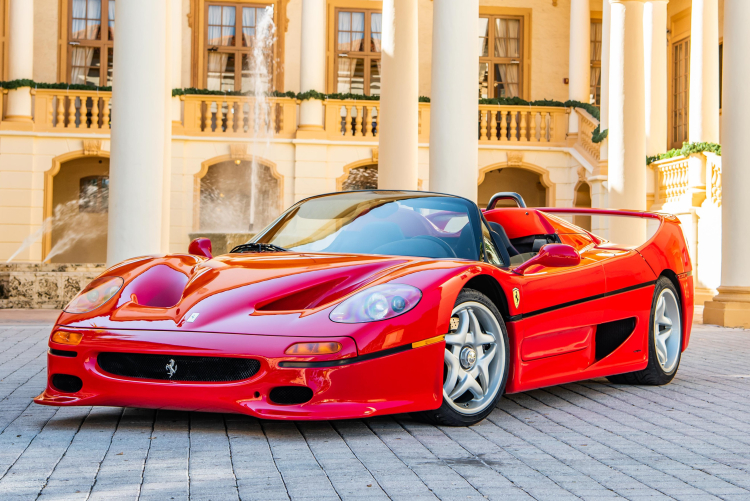

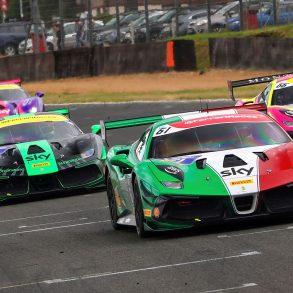

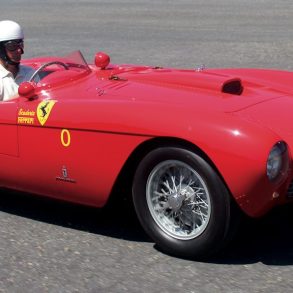
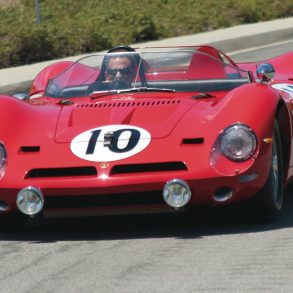
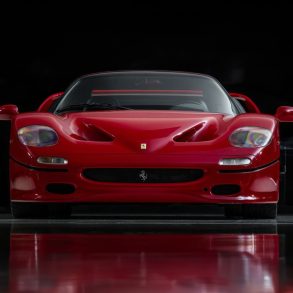


Gearbox first oil in f50
FERRARI f50 date on tires?
G2903987500082
Exaust foam first in ferrari f50,?